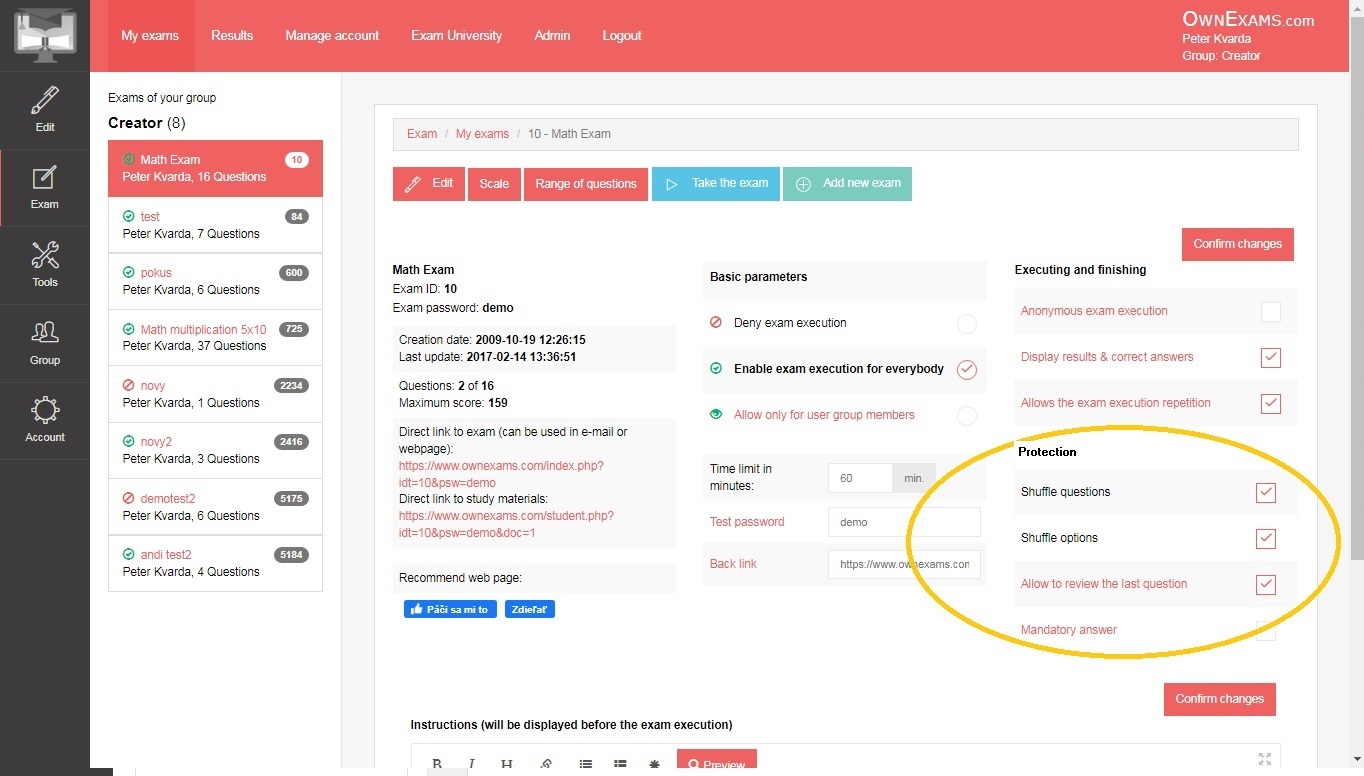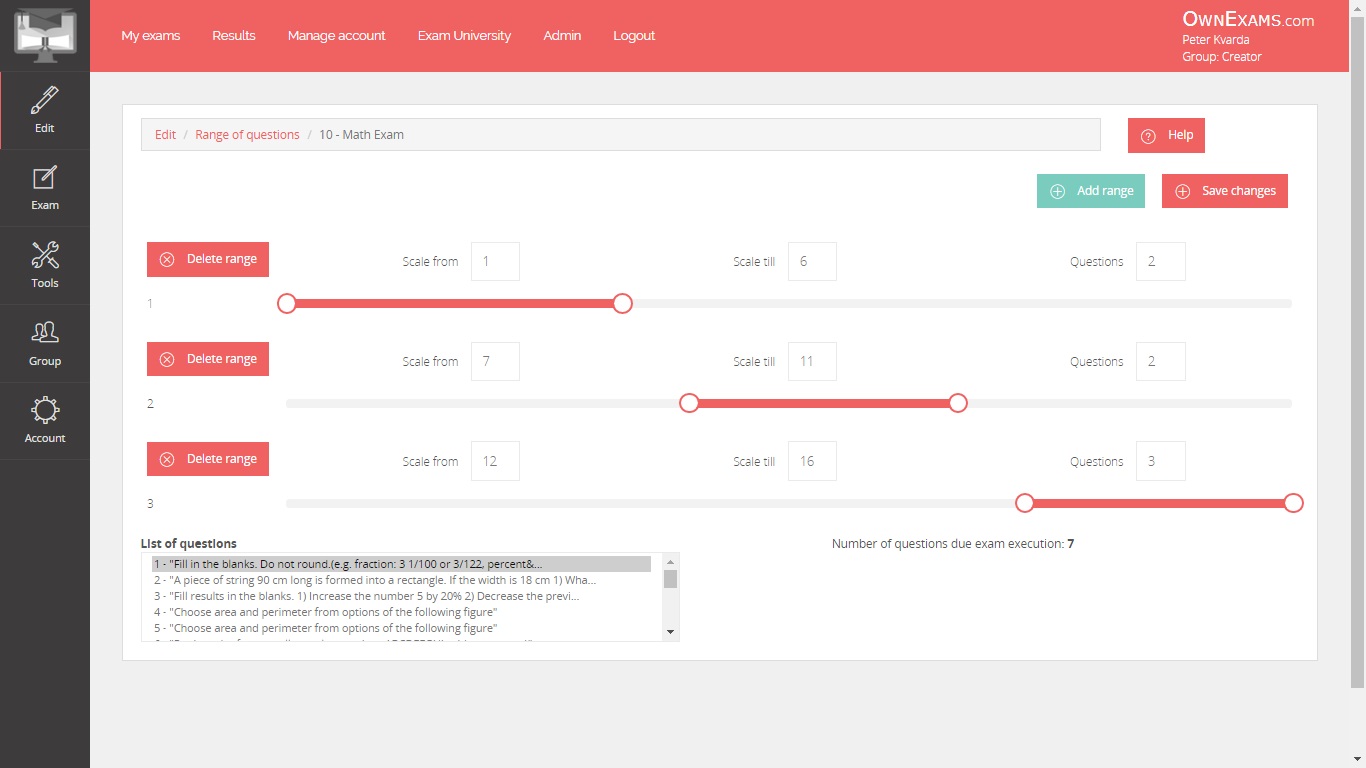OwnExams - an ideal testing tool for schools
Author: Peter Kvarda, Added: 24th January 2023
The ownexams.com testing portal provides a wide range of options for the safe and objective testing of pupils and students in schools. Based on consultations with teachers from practice, we managed to harmonize such criteria that description is almost impossible, even if students have directly visible to the screens. In this article we will show how to set the test parameters, whether to use the range of questions to achieve the most effective settings from the point of view of avoiding the possibility of writing. The actual creation of the test is described see the help at ownexams.com and for more information test creation.
Random order of questions and options
The basis of guaranteeing an objective evaluation of the student - in other words, the impossibility of writing, is the setting of test parameters on the introductory page "My tests" in the "Protection" section. These are the parameters "Randomize the order of the questions" and "Randomize the order of the options". When setting up random questions, test questions are always displayed in random order. This means that if the test has 10 questions, these 10 questions will appear to each student in a different order.
To make description even easier, setting the second option changes the order of the options for each question. Random order of options works for types "choice of options" and "assignment" questions. By randomly combining questions and options within questions, describing becomes almost impossible.

Time limit for performing the test
Another important factor is setting the correct test time limit in the basic test parameters on the "My Tests" home page. Time limit is mandatory data and it is not possible to turn it off completely. It is entered in minutes and if you want the test subjects not to be explicitly limited by time, it is necessary to set this limit with a larger margin. Students have the opportunity to complete the test even after the time limit has expired. The only difference is that after the time limit expires points are no longer added in the automatic evaluation. Points can then of course be added during manual evaluation.
However, in order to return to the question of the importance of the time limit in terms of objectivity, it is necessary to set this figure with a slight margin, so that the test can be performed calmly if the student has the right knowledge right in the head. We know the right answer the fastest, as soon as we can think of it and we don't have to it obtains it in other ways, such as by describing or searching the Internet. In this way, an objective test can be performed even at home, if the time limits are quite narrow and if, for example, the questions are formulated in such a way that they cannot be easily monitored on the Internet.
Select questions from a larger set
Another factor that can further complicate the description and help to achieve a realistic picture of knowledge even when repeating the test is the use of a larger set of questions. A larger set of questions means defining, for example, 30 questions, from which a random, e.g. 10. By this In this way, we achieve that each student is randomly selected different questions after starting the test and will be displayed in a random order. For a larger set questions (eg 100) there is an increased chance that the questions will be repeated only very rarely. With a large number of questions, the set is always selected at random each time the test is performed.
After creating the test, all questions are displayed automatically at startup. In order to change the number of questions when taking the test, it is necessary to change settings on the "Question Range" screen. In this section, we get to the selected test via the menu on the left, the "Edit" time. After opening the "Question Range" screen it is necessary to click on the "Add range" button. Then a line will appear with a range from the first to the last question, with the possibility of entering the number of questions.
Creating a range of questions can also serve us for the frequent situation where we have different areas of questions in one test, and we want each student to get the exact number of questions from each circle tests. We can do this setting easily by creating several ranges, for which we set the exact number to be selected at each execution. What does it look like, you can look at the following picture.

Conclusion
In conclusion, we can conclude that even a test on a computer can be objective and set safely, if we choose the right setting of random selection of questions and options, selection of questions from a larger set and the correct time limit. If you find these settings complicated or not enough time to come up with tests, you can contact us directly and we will be happy to we will advise or offer cooperation.
